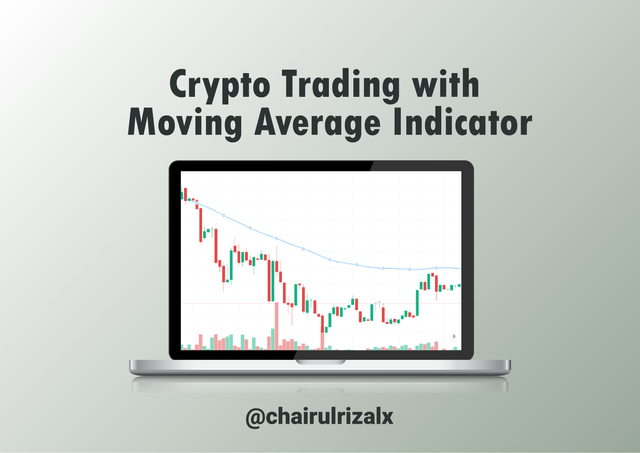 source edit with Adobe Illustrator
source edit with Adobe Illustrator
Hello Everyone
The Steemit Crypto Academy has entered Season 6 Week 2 with several changes implemented, most notably courses that are more focused on Trading knowledge. This week I'll be working on a homework assignment mentored by Professor @shemul21 on discusses Crypto Trading with Moving Averages. For a beginner like me, the Moving Average is one of the technical indicators that should be understood if you want to explore cryptocurrency trading and stocks.

1). Explain Your Understanding of Moving Average
Moving Average is a technical indicator that is used to identify and analyze the cryptocurrency or stock market where it functions as an indicator that follows the direction of the trend, as traders develop their knowledge of indicators, they also innovate and create moving average into several styles according to the needs of traders.
The Moving Average indicator calculates the average across a range of periods, from 15 minute, 20, to 100 days, depending on the demands of traders who want to analyze how long the time interval is. The shorter the time the trader chooses to calculate the average value, the more sensitive the price changes obtained, therefore we are not advised to use only one type of indicator when analyzing the market. The image below shows an example of the Moving Average indicator used in the SHIB/USDT market chart.
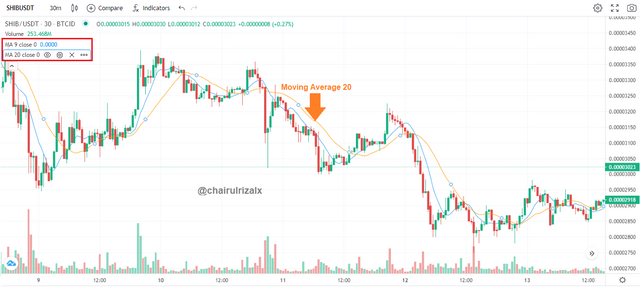 source
source
2). The Different Types of Moving Average
The use of indicators in the technical analysis allows traders to obtain the analysis results based on their preferences, with the inclusion of existing indications increasing the quantity of information received. Similar to the Moving Average Indicator, now there are many types of Moving Averages in addition to the previous ones and each type has its advantages, the following are the types of MA indicators and differences:
Simple Moving Average (SMA)
As the name implies, this Moving Average indicator calculates the average value of price movements from a certain period. It is important to know the basics of this Simple Moving Average in order to maximize the results of the analysis as desired. However, this indicator cannot provide certainty where the price movement will occur, the formula is:
SMA = Total price for one period / time period
If we enter the number 10 in the period column in the 1 hour time frame, this indicator will sum up the last 10 Close prices and the result will be divided by 10.
Exponential Moving Average (EMA)
This EMA indicator is faster in providing information if there is a change in the price trend in the market when compared to using the Simple Moving Average indicator. The use of this Exponential Moving Average can give more weight to the current price so that the signal sent can be faster, drawback of this indicator is that sometimes the signals given are false and inaccurate.
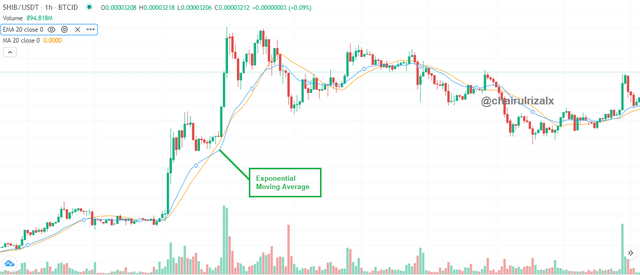 source
source[2/(Average period + 1)]
In the picture above on the blue line, the EMA moves closer to the candlestick than the orange line, the SMA (Simple Moving Average) indicator, with this example it can be said that the EMA (Exponential Moving Average) places more emphasis on the latest price movements, both uptrend, and downtrend.
Weighted Moving Average (WMA)
The Weighted Moving Average (WMA) is a development of the Simple Moving Average (SMA) with several different weights in its calculation, the advantage of the WMA is that it can predict because information about the current price is more important than the previous closing price. The Weighted Moving Average multiplies the factors to give different weights for different periods, here is the WMA formula:
WMA = [last price x weight factor] + [previous price x (weight factor -1)] + ...
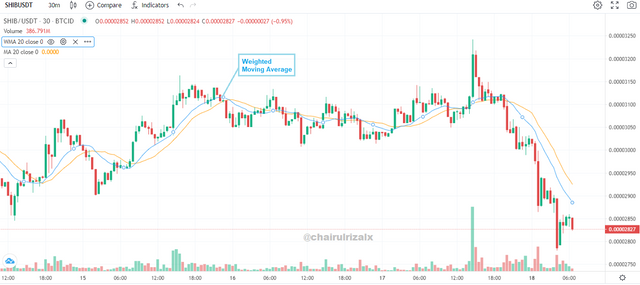 source
sourceDifference between SMA, EMA and WMA
Simple Moving Average (SMA)
- Calculates the average value of all data in one period then divided by the period.
- Displays smooth price charts and eliminates false signals
- Suitable for long period of time use
Exponential Moving Average (EMA)
- Calculates the average value by adding weight but the larger the period used, the smaller the weight of the last value.
- React faster to market price movements
- Suitable for short-term trading due to the rapid movement of prices to market changes
Weighted Moving Average (WMA)
- Calculates the average value by adding weight to the latest price which is bigger than the previous price.
- Faster and sensitive in price movements suitable for scalping.
- Focus more on the latest market prices to be one step ahead.
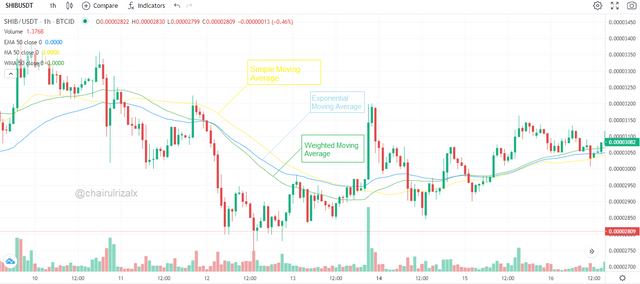 source
source
3). Identify Entry & Exit Point using Moving Average
Using the Moving Average indicator in trading will be very helpful if we understand how it works because if we make the wrong entry or exit, we will experience losses. In the following I will identify Entry and Exit points using Moving Averages, I use SMA 20 which serves as an indicator to identify trends in the market so that we can buy correctly. I also use the EMA 20 as a quick indicator to analyze recent price changes in the market.
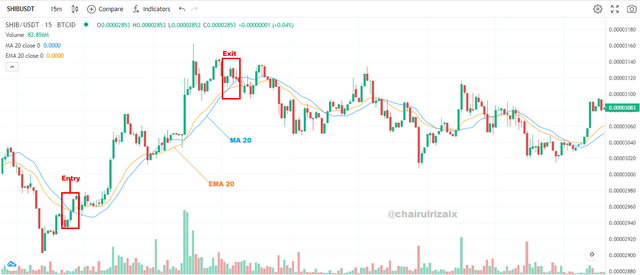 source
source
4). Understanding Moving Average Crossover
Crossover on the use of the Moving Average indicator is a cross between two Moving Average (MA) signal lines with different periods, this will happen if we use more than one MA indicator with different periods such as long or short periods. A crossover occurs when the two signal lines cross and it is a sign that there will be a change in a trend, be it an Uptrend or Downtrend.
When the short period MA signal line crosses above the long period MA signal, it is a sign that the signal will show Bullish, called the Golden Cross. If the short period MA signal line crosses below the long period MA signal, it becomes a signal that indicates Bearish or is called a Death Cross. False signals can be created if the movement of the chart on the market is experiencing sideways because it will be difficult to read the movement of when a trend change will occur.
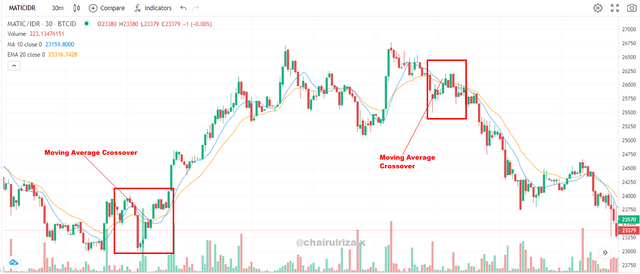 source
source
5). Limitations of Moving Average
Each technical indicator is made not only to be used separately, other supporting indicators are needed so that the analysis results obtained are maximum and there is no mistake in making choices when trading.
Like the Moving Average indicator, this indicator belongs to a lagging indicator whose value from market movements is obtained based on past prices, making it weak on accuracy in predicting current market prices. The use of moving averages will not be appropriate to reflect the latest trends or information on the market if they are used separately without the help of other technical indicators.
The MA indicator will be difficult for traders to utilize if the market price movement is unstable in certain trend conditions or Sideways because the signals on the MA will change in a short period of time and will trigger the appearance of false signals that are not profitable for traders in analyzing the market.

6). Conclusion
The use of indicators in the technical analysis allows traders to obtain the analysis results based on their preferences, with the inclusion of existing indications increasing the quantity of information received.
The Moving Average indicator calculates the average across a range of periods, from 15 minute, 20, to 100 days, depending on the demands of traders who want to analyze how long the time interval is, Using the Moving Average indicator in trading will be very helpful if we understand how it works because if we make the wrong entry or exit, we will experience losses.
The use of the Moving Average indicator depends on the trader, what type is used and the specified period must be appropriate and coupled with other technical indicators so that the analysis results can be as desired.
